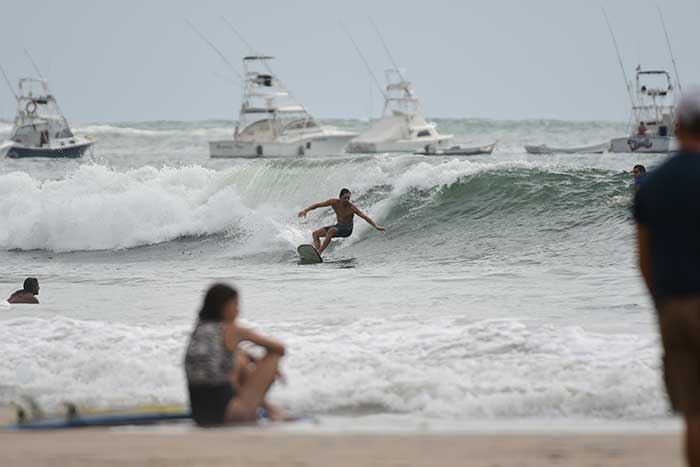
Pico Pequeño - Playa Tamarindo
Wave Quality: Average (6 / 10)
Ideal Swell Direction: SW (215° – 230°)
Ideal Wave Height: Waist high – shoulder high
Best Wind Direction: Light and variable
Best Tide: High
Required Experience: Advanced Beginner – Advanced.
Best Board: Soft-top, Longboard, Funboard, Fish
Bottom: Mostly sand with some reef
Crowd: Moderate – Heavy
Wave Power: (6 / 10)
Best time of the year: July & August
Pico Pequeño - Playa Tamarindo
Location – Pico Pequeño is located in the center of Tamarindo, approximately 150 meters south of the Tamarindo Beach Break and breaks just inside of the Pico Grande surf spot.
Pico Pequeño is the reform wave that breaks into the shore after initially exploding on the outside lava-thumb reef known as Pico Grande.
Wave Type / Quality – Wedging beach break (6 / 10) Average
Pico Pequeño is a fun reform wave that sits just on the inside of Pico Grande. The lava thumb reef will refract the outside wave into a reforming A-frame wedge that breaks close to the beach. This is considered a local’s favorite because of the consistent shape and surprising power. Even though the wave offers power and good shape, it is rare to catch this wave over shoulder high, which is why this spot falls into the average category.
Ideal Swell Direction – SW (215° – 230°)
Since Pico Pequeño has a due west orientation, there needs to be a fair amount of west in the corresponding swell. A strong storm that flares up in the South Pacific next to New Zealand or in the central South Pacific will send a healthy dose of SW swell.
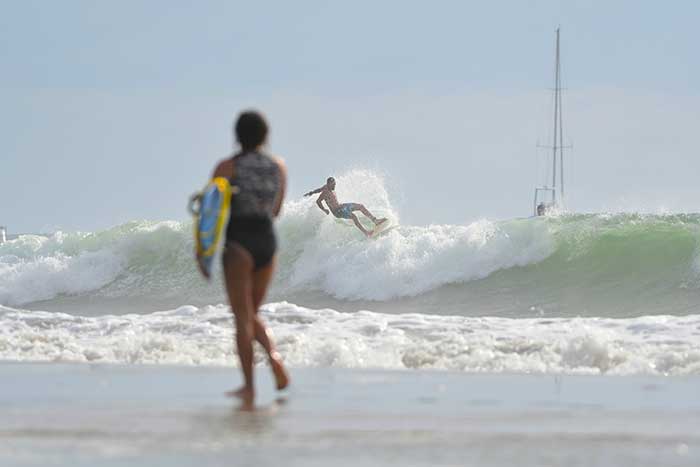
Ideal Wave Height – Waist – shoulder high
Since this wave is created from a reforming, already broken wave, much of the energy is lost beforehand. It is very rare that the wave will be bigger than shoulder high, even if other standout spots in the area are double overhead. In all honesty, the bigger the swell, the better when it comes to Pico Pequeno.
Best Wind Direction – Light & Variable
Wind direction is not so important at Pico Pequeño. As long as the wind is light, the wave will remain semi clean with open lines. It is common that clean-up sets will wash through the line up and keep the inside conditions fairly clean. Ideally, you want light offshore winds which can be any variation of East.
Rubber? – Yes (December – April)
Bring some rubber especially if the winds have been blowing offshore for several days. Although rare, water temps can drop down to about 63°F. This is a phenomenon called upwelling. Normally, water temps hover in the 75° – 80°F range. Upwelling really only happens a few times during the dry season. A wetsuit top generally comes in handy for dawn patrol sessions year round.
Best time to score? – July – August
July and August are known as Costa Rica’s “Mini-Summer” months where we receive consistent SW swells and offshore winds. This is your best chance of scoring a big swell with clean conditions.
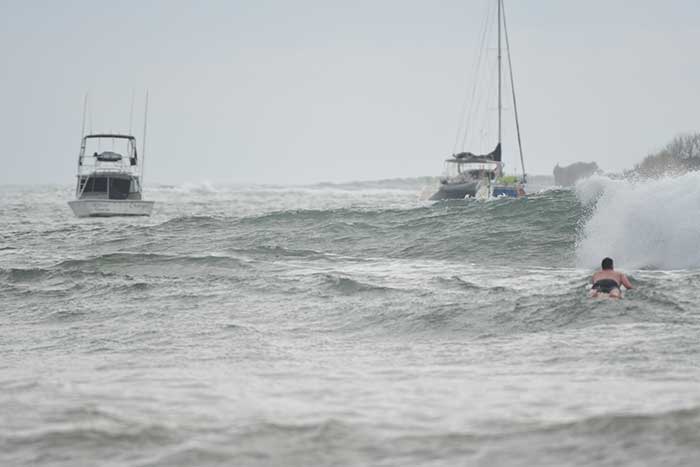
Best Tide – High
The higher the tide, the better. The very best scenario is either a full moon or a new moon when the high tide is extreme. When this happens, less energy is lost on the outer break (Pico Grande) and the swell filters through the inside with more size and power.
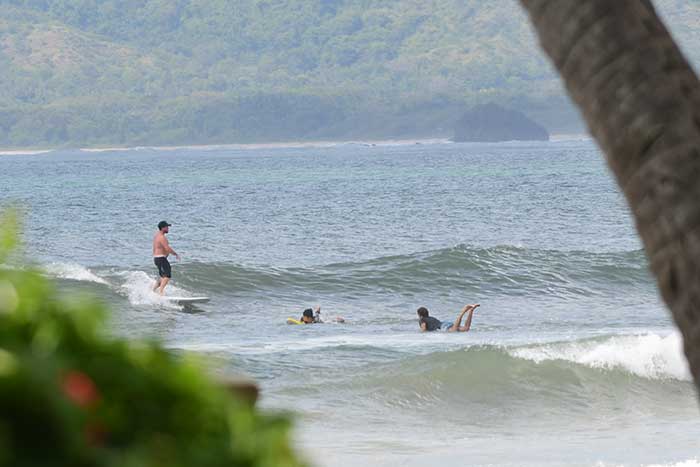
Required Experience – Advanced beginner – advanced
There is something for everyone at Pico Pequeño. The wave is easy enough that advanced beginners can get some fun rides here. This is actually a great place to learn to ride down the line since the wave is wedgie and not very fast. Advanced surfers will also find joy with the surprising power that these little wedges provide.
Best Board – Soft-top, longboard, funboard, fish
If you want to catch the most waves possible, grab a board with higher volume and plenty of foam. The best waves at Pico Pequeño start as white water and then reform into a fresh wedge peak. A high-volume board will help you make this connection from the outside white water into the inside wedge a little easier. A shortboard can also be fun when the waves are in the chest high + range.
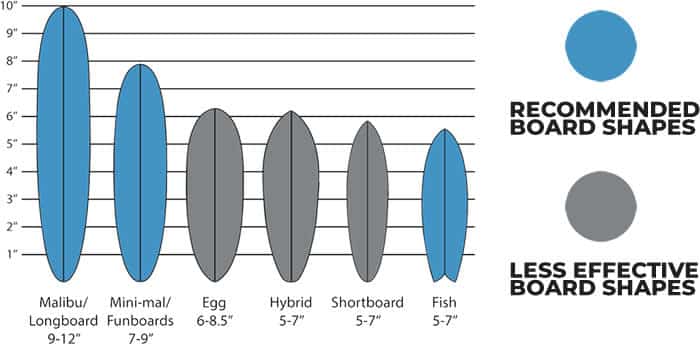
What’s On The Bottom? Mostly sand with some reef
On the outside where the wave initially breaks, it is a reef bottom. As the wave reforms and breaks again on the inside, it is a sandy bottom.
What’s The Crowd Like? – Moderate – heavy
This spot is certainly a local favorite. On any given day, you can find up to 20 + local Tico groms ripping this wave. Many of the locals also feel a bit entitled and will back paddle to the peak after catching each wave. A good strategy is to sit on the outside and catch the whitewater and do your best to pump through the deep section and into the inside wedge.
How Powerful Is The Wave? (5 / 10)
Although the wave is generally pretty small, it packs a punch as the wave reforms together. It is common to see Tico groms boosting airs on 1-2 foot wedges.
Perfecto Meter – (6/10) (1 = Lake Michigan wind chop / 10= Kelly Slater Surf Ranch)
On an ideal day with the perfect swell angle, offshore winds, and decent size, the wave offers 100M long rides with good shape and power. Generally there is a good end section as well to bang a final turn or air.
Spaghetti Arm Index – (5 / 10)
The wave breaks almost on the beach. The paddle out is short, but the waves are super consistent, breaking one after another. It’s easy to get tired from paddling. If you decide to only paddle out to the white water before the reform, this is an easier paddle but you’ll generally only catch small – medium sized waves.
Hazards – A few rocks, lots of people, lack of surf etiquette
How do I get there?
Pico Pequeño is about a 2 minute walk south from the Tamarindo Beach Break. This is the first lava rock outcropping you’ll see south of the Tamarindo estuary. You will recognize the wave as it reforms from larger waves breaking along the outer lava rock outcropping.
Download the Trip Guide
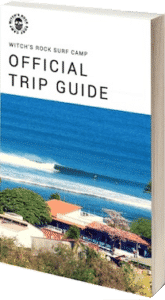
- See why guests return year after year
- Review all of our surf packages
- Learn what a typical week at surf camp looks like
- How to get here, what to pack, when to travel, and more…
